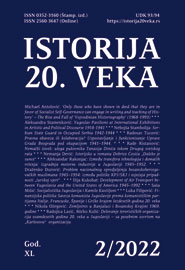IZMEĐU TRANSFERA TEHNOLOGIJA I DOMAĆIH REŠENJA: IZGRADNJA MOTORNE INDUSTRIJE U JUGOSLAVIJI 1945−1952.
BETWEEN TECHNOLOGY TRANSFER AND DOMESTIC SOLUTIONS: BUILDING THE MOTOR INDUSTRY IN YUGOSLAVIA 1945-1952
Author(s): Aleksandar RakonjacSubject(s): Social history, WW II and following years (1940 - 1949), Post-War period (1950 - 1989)
Published by: Institut za savremenu istoriju, Beograd
Keywords: Yugoslavia; Economy; Motorization; Truck; Tractor; Motorcycle
Summary/Abstract: This article aims to shed light on how the Yugoslav motor industry in the first post-war years sought to overcome the difficulties of mastering the technology of motor vehicle production on a modern industrial basis. During this period, gigantic efforts were made to get the country out of economic backwardness in the shortest possible time. The motor industry had one of the key roles on the path of modernization of the economy, and the state accordingly paid special attention to the construction of factories in this branch of industry. Reliance on pre-war pioneering moves of truck fabrication based on a license purchased in Czechoslovakia was the main capital with which began the process of emancipation of the domestic motor industry. Due to the impossibility to independently solve the issue of construction of all types of motor vehicles, help was sought abroad. Negotiations with the USSR and Hungary were started first, but even before the severance of all relations caused by the conflict between the Yugoslav and Soviet leadership, this attempt to establish cooperation failed. In the following years, after the failure in the East, the state concentrated all its efforts on establishing strong economic ties with the West. Thanks to favorable foreign policy circumstances, the reorientation of state policy had achieved great economic benefits for the further construction of the motor industry. Licenses for the fabrication of the “Ansaldo TCA/60” tractor were purchased, thus resolving the production of all heavy types of vehicles, as well as the production of oil-powered engines. By the early 1950s, cooperation had been established with several renowned companies from Germany, Italy and Switzerland, which provided opportunities for the Yugoslav engine industry to keep pace with the latest technological solutions. However, despite the transfer of technology that played a dominant role in raising the national car and tractor industry, domestic forces played a significant role in the production of the first air-cooled engine, a light wheeled tractor with a gasoline engine and the “Prvenac” truck. The Yugoslav example has shown that reliance on one’s own strength and international cooperation are two inextricably important factors in overcoming all the difficulties that come with the forced industrialization.
Journal: Istorija 20. veka
- Issue Year: 2022
- Issue No: 2
- Page Range: 405-422
- Page Count: 18
- Language: Serbian

